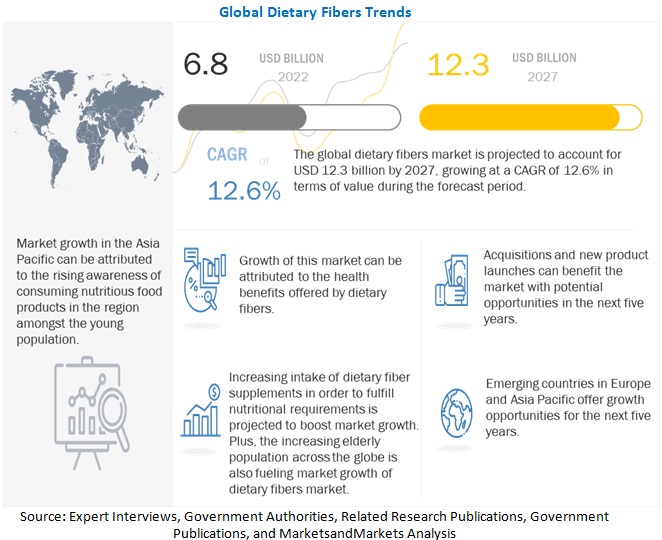Dietary Fibers Market worth $12.3 billion by 2027
Dietary Fibers Market Size, Share & Trends Report, 2027
According to a research report "Dietary Fibers Market by Source (Fruits & Vegetables, Cereals & Grains, Legumes, Nuts & Seeds), Type (Soluble, Insoluble), Application (Functional Food & Beverages, Pharmaceuticals, Feed, Nutrition, Other Application) & Region - Global Forecast to 2027", published by MarketsandMarkets, The global market is estimated at USD 6.8 billion in 2022. It is projected to reach USD 12.3 billion by 2027, recording a CAGR of 12.6% during the forecast period. Rising dietary fiber supplement intake to meet nutritional requirements is projected to augment market growth. Due to the aging population, increasing incidence of lifestyle diseases, and rising healthcare expenses, these supplements are in extremely high demand. Due to all these factors, consumer preferences are shifting toward consuming more dietary supplements to support their health and meet their basic nutritional requirements, driving the market growth.
Browse 367 market data Tables and 48 Figures spread through 333 Pages and in-depth TOC on "Dietary Fibers Market by Source (Fruits & Vegetables, Cereals & Grains, Legumes, Nuts & Seeds), Type (Soluble, Insoluble), Application (Functional Food & Beverages, Pharmaceuticals, Feed, Nutrition, Other Application) & Region - Global Forecast to 2027"
View detailed Table of Content here - https://www.marketsandmarkets.com/Market-Reports/novel-dietary-fibers-market-858.html

To know about the assumptions considered for the study, Request for Free Sample Report
Key Trends in the Global Dietary Fibers Market:
- Rising Demand for Functional Foods and Beverages: There is a growing demand for functional foods and beverages fortified with dietary fibers. Consumers are increasingly seeking products that offer health benefits beyond basic nutrition, such as improved digestive health, weight management, and blood sugar control.
- Focus on Health and Wellness: The overarching trend towards health and wellness is driving the demand for dietary fibers. Consumers are becoming more conscious of their dietary choices and are actively seeking products that support their health goals, including increased fiber intake for better digestive health and overall well-being.
- Preference for Natural and Plant-based Ingredients: There is a strong preference among consumers for natural and plant-based ingredients in food and beverage products. As such, dietary fibers sourced from natural sources such as fruits, vegetables, grains, and legumes are gaining popularity due to their perceived health benefits and clean label appeal.
- Growth in Functional Food Ingredients Market: The dietary fibers market is benefiting from the overall growth of the functional food ingredients market. Food and beverage manufacturers are incorporating dietary fibers into a wide range of products, including bread, cereals, snacks, dairy products, and beverages, to enhance their nutritional profile and appeal to health-conscious consumers.
- Innovation in Product Formulations: There is ongoing innovation in the development of dietary fiber ingredients and formulations to meet consumer preferences and address specific health needs. This includes the introduction of novel fiber sources, such as resistant starches, soluble fibers, and prebiotic fibers, as well as advancements in extraction and processing technologies to improve the functional properties of dietary fibers.
- Regulatory Landscape and Labeling Requirements: Regulatory standards and labeling requirements for dietary fiber ingredients are evolving, impacting product formulation, labeling, and marketing strategies. Manufacturers need to ensure compliance with regulations while effectively communicating the health benefits of dietary fibers to consumers.
- Expansion in Emerging Markets: The demand for dietary fibers is witnessing significant growth in emerging markets, driven by factors such as rising disposable incomes, urbanization, changing dietary habits, and increasing awareness about the importance of fiber-rich diets for health and wellness. This presents opportunities for market players to expand their presence in these regions.
- Research and Education Initiatives: Ongoing research and education initiatives aimed at raising awareness about the health benefits of dietary fibers are contributing to market growth. Consumer education campaigns, as well as collaborations between industry stakeholders and research institutions, are helping to highlight the importance of fiber-rich diets for preventing chronic diseases and promoting overall health.
Top Companies in the Dietary Fibers Market
Dietary Fibers Market Report Segmentation:
This research report categorizes the market based on type, application, source, and region.
|
By Source |
By Type |
By Application |
By Region |
|
|
|
|
Recent Developments in the Dietary Fibers Market
- In April 2022, Ingredion Incorporated acquired Germany-based KaTech, that provides advanced texture and stabilization solutions to the food and beverage industries. This acquisition expands Ingredion's Food Systems platform with a comprehensive suite of innovative solutions that assist food and beverage manufacturers with product formulation, ingredient functionality, and technical assistance.
- In March 2021, BENEO constructed its chicory root fiber manufacturing unit in Chile. This expansion to help BENNEO to solidify its position in the global market.
- In September 2020, Tate & Lyle opened a new Customer Innovation and Collaboration Center in Santiago, Chile. The new center includes application and rapid prototyping capabilities, which will allow Tate & Lyle's food scientists to collaborate with customers in the region to address the growing demand for solutions that help reduce sugar, fat, and calories and add fiber to consumer products.
Frequently Asked Questions (FAQ):
Which region is projected to account for the largest share in the dietary fibers market?
North America dominated the dietary fibers market with largest share of 34.3% of the overall market in 2021
How big is the global dietary fibers market?
The global Dietary fibers market is estimated at USD 6.8 Billion in 2022. It is projected to reach USD 12.3 Billion by 2027, recording a CAGR of 12.6% during the forecast period
Which are the key players in the dietary fibers market, and how intense is the competition?
Key players in this market include Beneo (Germany), ADM (US), Tereos (France), Cargill (US), Dupont (US), Roquette Frères (France), Ingredion Incorporated (US), Kerry Group PLC (Ireland), The Green Labs LLC (US), Nexira (France), Tate & Lyle (UK), Nutri Pea Ltd (Canada), Herbafood Ingredients GmbH (Germany), Scoular (US), and Baolingbao Biology Co Ltd. (China). Companies are aiming on growing their manufacturing and R&D facilities by entering into partnerships and agreements as well as by launching new products to mark their footprint in the global market. .
What is the leading application in the dietary fibers market?
The functional food & beverages segment was the highest revenue contributor to the market, with USD 2,684.0 million in 2021, and is estimated to reach USD 5,720.9 million by 2027, with a CAGR of 13.4%. The pharmaceuticals segment is estimated to reach USD 2,221.4 million by 2027, at a significant CAGR of 12.4% during the forecast period.
Is there Oceania (New Zealand and Australia) specific information (market size, players, growth rate) for dietary fibers market?
On request, We will provide details on market size, key players, and growth rate of this industry in the Oceania region. Also, you can let us know if there are any other countries of your interest.
What is the leading source in the dietary fibers market?
The cereals & grains segment was the highest revenue contributor to the market, with USD 2,269.2 million in 2021, and is estimated to reach USD 4,770.8 million by 2027, with a CAGR of 13.2%.
About MarketsandMarkets™
MarketsandMarkets™ provides quantified B2B research on 30,000 high growth niche opportunities/threats which will impact 70% to 80% of worldwide companies’ revenues. Currently servicing 7500 customers worldwide including 80% of global Fortune 1000 companies as clients. Almost 75,000 top officers across eight industries worldwide approach MarketsandMarkets™ for their painpoints around revenues decisions.
Our 850 fulltime analyst and SMEs at MarketsandMarkets™ are tracking global high growth markets following the "Growth Engagement Model – GEM". The GEM aims at proactive collaboration with the clients to identify new opportunities, identify most important customers, write "Attack, avoid and defend" strategies, identify sources of incremental revenues for both the company and its competitors. MarketsandMarkets™ now coming up with 1,500 MicroQuadrants (Positioning top players across leaders, emerging companies, innovators, strategic players) annually in high growth emerging segments. MarketsandMarkets™ is determined to benefit more than 10,000 companies this year for their revenue planning and help them take their innovations/disruptions early to the market by providing them research ahead of the curve.
MarketsandMarkets’s flagship competitive intelligence and market research platform, "Knowledgestore" connects over 200,000 markets and entire value chains for deeper understanding of the unmet insights along with market sizing and forecasts of niche markets.
Contact:
Mr. Aashish Mehra
MarketsandMarkets™ INC.
630 Dundee Road
Suite 430
Northbrook, IL 60062
USA : 1-888-600-6441
sales@marketsandmarkets.com
- Triangulate with your Own Data
- Get Data as per your Format and Definition
- Gain a Deeper Dive on a Specific Application, Geography, Customer or Competitor
- Any level of Personalization
- What are the Known and Unknown Adjacencies Impacting the Dietary Fibers Market
- What will your New Revenue Sources be?
- Who will be your Top Customer; what will make them switch?
- Defend your Market Share or Win Competitors
- Get a Scorecard for Target Partners







